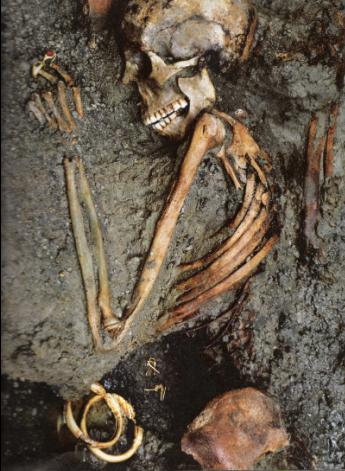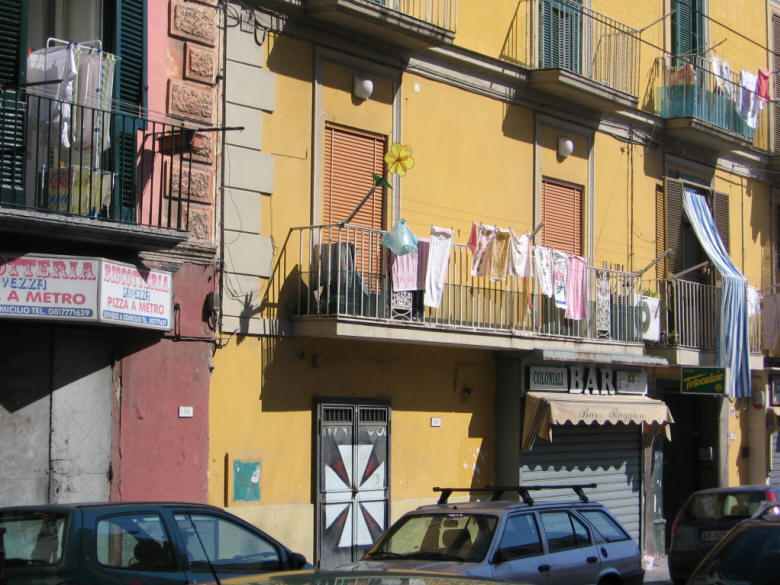|
Herculaneum/naples
21 sept.
we are up early and decide to brave the autrostrada
again. with a staggering number of helpful signs everywhere, we end
up in a narrow little road that unbelievably takes us directly to
Herculaneum. so overwhelmed by the numbing lack of traffic, absence of
tourists or their stupid buses and the ability to park absolutely
anywhere, we freak and drive a kilometre away and leave the beast on the
sidewalk with the hood up. there is only a slim chance it will still be
there when we get back, but if we drink enuf, it probably won't matter.
 Herculaneum
now found under the charming Naples suburb of Ercolano, was an
ancient Roman town destroyed, along with Pompeii, in the eruption
of Mount Vesuvius beginning on the afternoon of August 24, AD 79.
During the night, the column of volcanic debris which had risen
into the stratosphere, began falling back down onto Vesuvius. A
pyroclastic flow formed that sent a mixture of 400°C (750°F) gas,
ash, and rock racing down toward Herculaneum at 100 mph. At about
1 AM it reached the boat houses where its intense heat killed the
inhabitants within seconds. This flow and several following did
little damage to the structures, instead slowly filling the
structures from the bottom up. Herculaneum
now found under the charming Naples suburb of Ercolano, was an
ancient Roman town destroyed, along with Pompeii, in the eruption
of Mount Vesuvius beginning on the afternoon of August 24, AD 79.
During the night, the column of volcanic debris which had risen
into the stratosphere, began falling back down onto Vesuvius. A
pyroclastic flow formed that sent a mixture of 400°C (750°F) gas,
ash, and rock racing down toward Herculaneum at 100 mph. At about
1 AM it reached the boat houses where its intense heat killed the
inhabitants within seconds. This flow and several following did
little damage to the structures, instead slowly filling the
structures from the bottom up.The
amazingly good state of preservation of the structures and their
contents was due to three factors: by the time the wind changed
and ash began to fall on Herculaneum, the structures were already
filled up and the roofs did not collapse; the intense heat of the
first pyroclastic flow carbonized the surface of organic materials
and extracted the water from them; and the deep (up to 25 meters),
dense tuff formed an airtight seal over Herculaneum for 1700
years.
After the eruption of Mount Vesuvius, the town
of Herculaneum was buried under 50-60 feet (approx. 20 metres) of
lava, mud and ash. It laid hidden and nearly intact for more than
1600 years until it was accidentally discovered by some workers
digging a well in 1709. However, once the nearby town of
Pompeii was discovered, which was significantly easier to excavate
due to the reduced amount of debris covering the site (four metres
as opposed to Herculaneum's twenty metres), digging stopped. In
the twentieth century, however, excavation once again resumed in
the town. However, many public and private buildings, including
the forum complex, are yet to be excavated
 It
was long thought that nearly all of the inhabitants managed to
escape because initial excavations revealed only a few skeletons.
It wasn't until 1982 when the excavations reached boat houses on
the beach area that this view changed. In 12 boat houses
archaeologists discovered 250 skeletons huddled close together, of
varied age, sex, and class. The skeletons were preserved on the
seafront, where people had fled in an attempt to escape the
volcanic disaster, including the 'ring lady' who gives her name to
the house where she was found. It
was long thought that nearly all of the inhabitants managed to
escape because initial excavations revealed only a few skeletons.
It wasn't until 1982 when the excavations reached boat houses on
the beach area that this view changed. In 12 boat houses
archaeologists discovered 250 skeletons huddled close together, of
varied age, sex, and class. The skeletons were preserved on the
seafront, where people had fled in an attempt to escape the
volcanic disaster, including the 'ring lady' who gives her name to
the house where she was found.
The volcanic mud, ash and debris covering
Herculaneum, along with the extreme heat, left it in a
remarkable state of preservation for over 1500 years.
However, once excavations began, exposure to the elements
began the slow process of deterioration. This was not
helped by the methods of archaeology used earlier in the
town's excavation, which generally centered around
recovering valuable artefacts rather than ensuring the
survival of all artefacts. The carbonised remains of
organic materials, when exposed to the air, deteriorated
over a matter of days, and destroyed many of the remains
until a way of preserving them was formed. Today, tourism
and vandalism (huh?) has damaged many of the areas open to
the public, and water damage coming from the modern
Ercolano has undermined many of the foundations of the
buildings. Reconstruction efforts have often proved
counterproductive, however in modern times conservation
efforts have been more successful. Today excavations have
been temporarily discontinued, in order to direct all
funding to help save the city....sure. that is why the
place is covered with places to put garbage ( here in
canada we call them 'waste receptacles'), the odd security
guard ie to protect all of that ancient graffiti, blah
blah blah.
click on a
picture to see a larger image. hit arrows at either end of the slideshow
for more pictures.
we are about 1 km from herculaneum. we 'leave' the car on the sidewalk. l pray that at least some of it is left there when we get back downtown naples, heading to herculaneum. your typical front/backyard in naples herculaneum with vesuvius in the background. look mid foreground and you can see almost 50 ft of ash separating old from new the only worker we see working....apparently 'repairing' the ruins. cool. this could have been my place if l was over 2000 years old and really rich. Herculaneum, Neptune and Amphitrite...the whole gang is here the main drag. it is stinking, hot... we find graffiti.....quite possibly original!....jim excitedly deciphers...his latin is much better than mine..."do not read the sign"...... on the way back to the car...praying, praying we are nearing where we think we've left the car...it is on the other side of the wall. praying, praying...

we are about 1 km from herculaneum. we 'leave' the car on the sidewalk. l pray that at least some of it is left there when we get back
• Up • anzio • cassino • Herculaneum • Vesuvius • Pompeii • amalfi coast • stromboli • Sicily • Eastern Adriatic • |
 Herculaneum
now found under the charming Naples suburb of Ercolano, was an
ancient Roman town destroyed, along with Pompeii, in the eruption
of Mount Vesuvius beginning on the afternoon of August 24, AD 79.
During the night, the column of volcanic debris which had risen
into the stratosphere, began falling back down onto Vesuvius. A
pyroclastic flow formed that sent a mixture of 400°C (750°F) gas,
ash, and rock racing down toward Herculaneum at 100 mph. At about
1 AM it reached the boat houses where its intense heat killed the
inhabitants within seconds. This flow and several following did
little damage to the structures, instead slowly filling the
structures from the bottom up.
Herculaneum
now found under the charming Naples suburb of Ercolano, was an
ancient Roman town destroyed, along with Pompeii, in the eruption
of Mount Vesuvius beginning on the afternoon of August 24, AD 79.
During the night, the column of volcanic debris which had risen
into the stratosphere, began falling back down onto Vesuvius. A
pyroclastic flow formed that sent a mixture of 400°C (750°F) gas,
ash, and rock racing down toward Herculaneum at 100 mph. At about
1 AM it reached the boat houses where its intense heat killed the
inhabitants within seconds. This flow and several following did
little damage to the structures, instead slowly filling the
structures from the bottom up. It
was long thought that nearly all of the inhabitants managed to
escape because initial excavations revealed only a few skeletons.
It wasn't until 1982 when the excavations reached boat houses on
the beach area that this view changed. In 12 boat houses
archaeologists discovered 250 skeletons huddled close together, of
varied age, sex, and class. The skeletons were preserved on the
seafront, where people had fled in an attempt to escape the
volcanic disaster, including the 'ring lady' who gives her name to
the house where she was found.
It
was long thought that nearly all of the inhabitants managed to
escape because initial excavations revealed only a few skeletons.
It wasn't until 1982 when the excavations reached boat houses on
the beach area that this view changed. In 12 boat houses
archaeologists discovered 250 skeletons huddled close together, of
varied age, sex, and class. The skeletons were preserved on the
seafront, where people had fled in an attempt to escape the
volcanic disaster, including the 'ring lady' who gives her name to
the house where she was found. 














